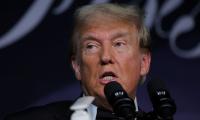Finally, PTI chairman Imran Khan launched his much hyped and long-awaited ‘Haqeeqi Azadi March’ from Liberty Roundabout Lahore towards Islamabad on Friday. Thousands of PTI supporters participated in the first day of the long march led by former PM Imran Khan.
The march came to an end at Data Darbar around midnight. PTI leaders including Imran Khan went back to their comfortable homes to have a good night’s sleep during the night. The second day of the long march started on Saturday from Shahdara Chowk Lahore and – till the writing of this column – was supposed to spend the day on GT Road.
Day one of the march in Lahore was not impressive – though it would also be wrong to declare it a failure. It was a good political show. But not something the PTI leader had told us it would be. It was neither a tsunami nor a sea of people on the streets of Lahore. The PTI failed to put up an exceptional show of strength and popular support – something matching October 2011.
The PTI’s organizational weakness once again stands exposed. Imran Khan ignored the party’s organizational side while he was in power. Agitational politics needs a strong and vibrant organizational structure and politically well-trained cadres. The PTI lacks both at the moment.
When Imran Khan ended his first long march in Islamabad on the morning of May 26, he promised to return with the second march within a week. But it took Imran Khan nearly five months to launch his decisive march to Islamabad. During this period, the PTI organized more than 50 public rallies and spent billions of rupees to prepare for this march.
It seems that Imran Khan delayed the second march for months to strike a deal with the powers that be to hold fresh elections immediately and have a say in the November appointment.
Now both sides have publicly accepted that secret meetings took place between the two, including Imran Khan, to settle the issues. But it seems that these meetings failed to bring the desired results for the PTI. The launching of the second long march by the PTI and the joint presser by the ISI DG and DG ISPR clearly indicates that nothing really has been achieved through any talks.
So when all hopes were dashed, the PTI announced its much delayed march to Islamabad. It seems that Imran Khan’s strategy to secretly engage while also openly attacking the same people didn’t work well. He tried to put pressure to gain political objectives, but didn’t succeed.
Imran Khan made a hard-hitting speech before kicking off the long march towards Islamabad. Since the Thursday presser, which exposed Imran Khan’s narrative of regime change as well as his anti-establishment rhetoric, Imran seems upset and angry.
His fallout with old friends might not help his cause. In my view, the PTI as a political party is not prepared to take on this challenge. It seems Imran is headed for a final showdown with his opponents. His failure might prove costly for the PTI. But it seems he feels that he is left with no other option but to fight this do-or-die political battle.
Imran Khan wants to achieve two clear political objectives through this march. One is to force the ruling coalition to announce fresh elections immediately. The other is to somehow influence the November appointment. Through this ‘Azadi March’ he wants to achieve both of his political objectives.
Imran thinks that early elections suit him because he is very popular at the moment. He can win the elections to form the next government. It is indeed true that Imran Khan is the most popular leader in the country at the moment. But he is still not in a position to sweep elections across the country. He looks very popular because his opponents have become unpopular.
What the ruling coalition is facing today Imran Khan was facing when he was in power. And in fact he lost most of the by-polls when in power. The people used to complain about the high inflation and falling incomes. The PTI government’s economic policies and its poor performance made it unpopular. But Imran recovered his lost ground and regained popularity after his ouster from power, using an anti-American and anti-establishment narrative to play the victim card.
Now the ruling coalition is facing the same situation. The people are not happy at all with the economic policies of the current government. The inflation has almost doubled in the last six months. There were high hopes in sections of society that the PML-N led coalition government would be able to bring down the tsunami of price hike. But all these hopes dashed as the ruling coalition implemented harsh IMF conditions to revive the IMF programme. The people are – once again – left disappointed and betrayed.
Imran Khan knows well that if the coalition government succeeded in bringing down the inflation and providing much needed relief to the people then the situation could change again. So he is going all-out to press both sll power stakeholders, including the government, to announce the elections immediately.
Now the question that arises here is: will Imran Khan be able to put enough pressure to achieve both or at least one political objective of this week-long march? The peaceful march and sit-in at a designated place in Islamabad might not be enough to force the government to announce the fresh elections. A crowd of 50,000 or even 1, 00,000 (one hundred thousand or more) might not be enough to force the government to accept both the demands of the PTI.
The writer is a freelance journalist.
Most SOEs such as PIA, may have a negative net worth too, based on their earnings potential
Fortunately, after a decade’s struggle with smog, Pakistani Punjab has understood the urgency of climate action
Recent COP29 summit underscored several emerging opportunities in global climate action
Rapid industrialisation of nations blurred once-clear lines between ‘developed’ and ‘developing’
Analysis of registered candidates reveals that many come from 15 districts affected by floods, poverty and poor...
US-Pakistan relations need to steer clear of the global power competition that dominates geopolitical landscape







